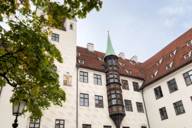
Alter Hof in Munich's old town was the residence of the Wittelsbach dynasty for over two centuries and today combines medieval and modern architectural elements.
Alter Hof, formerly called Alte Veste or Ludwigsburg, is nestled in Munich’s old town, just a few minutes from Marienplatz (main square). As soon as you enter Alter Hof through the gate tower via Burgstrasse, you are immersed in the city's history: The Wittelsbach family ruled from here from the 13th to the 15th century and were Bavaria's ruling dynasty.
Even before Bavaria was divided for the first time in 1255, when Duke Ludwig II received the Duchy of Bavaria, it is said that there was a kind of castle complex or another building with a surrounding moat on this spot. In those times, it was customary for the dukes' residence to be built on the outskirts of the city so that they could flee quickly in the event of riot or attack.
A story that is still told today allegedly happened during the time when said Duke Ludwig II lived at the court with his children. At that time, some unusual pets were kept, and it is said that a trained monkey snatched Ludwig's little son, who was also called Ludwig, out of his cradle and climbed with him onto the roof of the Gothic wooden bay window. The nanny and other servants of the court managed to lure the monkey down again, so that little Ludwig could be put back into his cot unharmed. This is how the oriel got its name Affenturm or Affentümchen – monkey tower. According to today´s knowledge, however, the tower was built later.
Little Ludwig became very ambitious, pursued an impressive career and had himself crowned emperor in 1328 as “Ludwig der Bayer“ (Ludwig the Bavarian). Alter Hof then became the imperial residence for two decades. The city kept growing and subsequent rulers found Alter Hof too insecure as far as defence options were concerned. Therefore, as early as 1385, the Neuveste, the building before today's Residence (city palace), was built as a ducal moated castle on Munich's outermost city fortifications.
The Neuveste castle served as a refuge for some time and was used as the residence of the Bavarian dukes from the early 15th century. For this reason, Alter Hof was then converted into the administrative headquarters. Also, members of the duke`s court and family stayed here. Since the end of the 16th century, Alter Hof was repeatedly rebuilt or extended. In addition, parts of Alter Hof that had been destroyed in the Second World War were replaced by new buildings. These eventually transformed the complex into an ensemble of the five buildings that can be found today: Burgstock, Zwingerstock, Lorenzistock, Pfisterstock and Brunnenstock.
The famous Gothic bay window, also known as the Affentürmchen – monkey tower –, is located on the western floor of the castle. The state office for non-governmental museums in Bavaria and the Infopoint Museen und Schlösser in Bayern (information point for museums and palaces in Bavaria) are located in the eastern part of the castle, next to the gate tower. In the late Gothic vaulted cellar, which dates from around 1300, you can visit the exhibition “Münchner Kaiserburg“ (Munich Imperial Castle), which tells the history of the city of Munich in an interesting multimedia presentation.
The Lorenzistock is located on the north side of the courtyard and is separated from the Pfisterstock by the gateway to the courtyard moat. The Pfisterstock stretches across the corner and merges with the Brunnenstock on the east side. Behind the gateway to the Hofgraben is an equestrian statue of Ludwig der Bayer (Ludwig the Bavarian).
In 2001, a private investor developed the three building sections Lorenzistock, Pfisterstock and Brunnenstock: Lorenzistock was rebuilt according to designs by Professor Peter Kulka. Brunnenstock and Pfisterstock were demolished and completely rebuilt by the architectural firm Auer+Weber Assoziierte GmbH.
Today, there are many shops and restaurants around the Alter Hof. Due to its central location in the old town, many of Munich's world-famous sights are within walking distance.